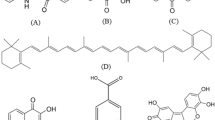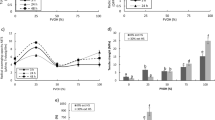Abstract
There is currently much interest in natural phenolic compounds as bioactive components of food. The roles of many fruits and vegetables in disease prevention have been attributed, in part, to the antibacterial and antioxidant properties of their constituent polyphenols. In this study, cotton fabrics were treated by phenolic compounds, pyrogallol, phloroglucinol, pyrocatechol, and resorcinol, to assess their antibacterial and antioxidant capabilities on clothing material. The treatment was conducted via a pad-dry-cure process and 1,2,3,4,-butanetetra carboxylic acid was used as a crosslinker in the finishing process to improve the treatment efficiency. After the finishing step, the phenolic compound treated cotton fabrics were investigated by FT-IR, color spectrophotometry, an antibacterial test, and an antioxidant test. Through the investigation, it was discovered pyrogallol is the most effective phenolic compound for cotton treatment, and the treated cotton fabric shows >99.9 % antibacterial ability and >90 % antioxidant ability.







Similar content being viewed by others
References
Alger MSM (1997) Polymer science dictionary. Springer, London, p 152
Alonso C, Martí M, Martínez V, Rubio L, Parra JL, Coderch L (2013) Antioxidant cosmeto-textiles: skin assessment. Eur J Pharm Biopharm 84:192–199
Busta FF, Foegeding PM (1983) Chemical food preservatives. Disinfection, sterilization and preservation. Lea and Febiger, Philadelphia, pp 656–694
Han J, Weng XC, Bi KS (2008) Antioxidants from a Chinese medicinal herb: Lithospermum erythrorhizon. Food Chem 106:2–10
Hättenschwiler S, Vitousek PM (2000) The role of polyphenols in terrestrial ecosystem nutrient cycling. Trends Ecol Evol 15(6):238–243
Hong KH, Bae JH, Jin SR, Yang JS (2012) Preparation and properties of multi-functional cotton fabrics treated by extracts of gromwell and gallnut. Cellulose 19(2):507–515
Koh EM, Hong KH (2014) Gallnut extract-treated wool and cotton for developing green functional textiles. Dyes Pigm 103:222–227
Kut D, Güneşoǧlu C, Orhan M (2010) Crease-resistant Finish of linen/viscose blend fabrics. Fibres Text East Eur 18(6):91–93
Lee J, Broughton RM, Akdag A, Worley SD, Huang T (2007) Antimicrobial fibers created via polycarboxylic acid durable press finishing. Text Res J 77(8):604–611
Michalak A (2006) Phenolic compounds and their antioxidant activity in plants growing under heavy metal stress. Pol J Environ Stud 15(4):523–530
Milic BL, Djilas SM, Canadanovic-brunet JM (1998) Antioxidative activity of phenolic compounds on the metal-ion breakdown of lipid peroxidation system. Food Chem 61(4):443–447
Pannu S (2013) Investigation of natural variants for antimicrobial finishes in innerwear a review paper for promotion of natural hygiene in innerwear. Int J Eng Trends Technol (IJETT) 4(5):2168–2171
Ramya K, Maheshwari V (2013) Analysis of the antimicrobial efficacy of bamboo/cotton knitted fabric finished with the extracts of the Syzygium aromaticum buds. J Text Sci Eng 3(3):1–5
Rice-Evans CA, Miller NJ, Paganga G (1997) Antioxidant properties of phenolic compounds. Trends Plant Sci 2(4):152–159
Shahid-ul-Islam, Shahid M, Mohammad F (2013) Green chemistry approaches to develop antimicrobial textiles based on sustainable biopolymers—a review. Ind Eng Chem Res 52(15):5245–5260
Teli MD, Sheikh J, Kamble M (2013) Ecofriendly dyeing and antibacterial finishing of soyabean protein fabric using waste flowers from temples. Text Light Ind Sci Technol (TLIST) 2(2):78–84
Thiele JJ, Dreher F, Packer L (2000) Antioxidant defense systems in skin. In: Elsner P, Maibach HI (eds) Drugs versus cosmetics: cosmeceutical?. Dekker, NY, pp 145–187
Ting WW, Vest CD, Sontheimer R (2003) Practical and experimental consideration of sun protection in dermatology. Int J Dermatol 42:505–513
Vermerris W, Nicholson R (2009) Phenolic compound biochemistry, chapter 2. Springer, Netherlands, p 48
Xu W, Li Y (2000) Cotton fabric strength loss from treatment with polycarboxylic acids for durable press performance. Text Res J 70(11):957–961
Yang CQ (1991) Characterizing ester crosslinkages in cotton cellulose with FT-IR photoacoustic spectroscopy 1. Text Res J 61(5):298–305
Acknowledgments
This research was supported by Basic Science Research Program through the National Research Foundation of Korea (NRF) funded by the Ministry of Science, ICT & Future Planning (NRF-2014R1A1A3049962).
Author information
Authors and Affiliations
Corresponding author
Electronic supplementary material
Below is the link to the electronic supplementary material.
Rights and permissions
About this article
Cite this article
Hong, K.H. Preparation and properties of phenolic compound/BTCA treated cotton fabrics for functional textile applications. Cellulose 22, 2129–2136 (2015). https://doi.org/10.1007/s10570-015-0604-4
Received:
Accepted:
Published:
Issue Date:
DOI: https://doi.org/10.1007/s10570-015-0604-4




